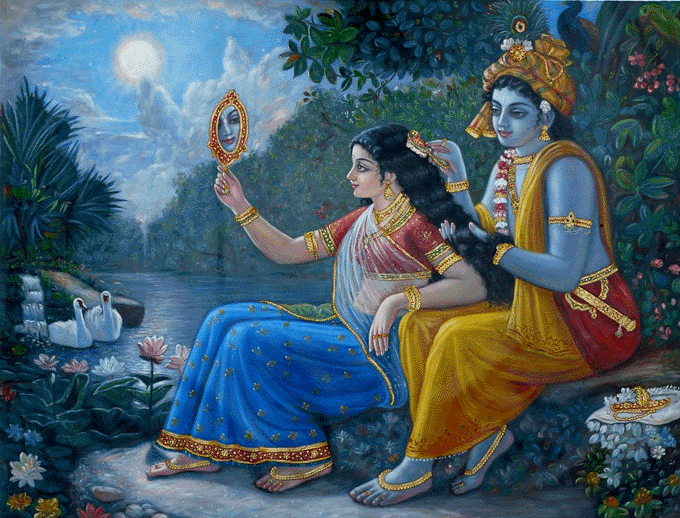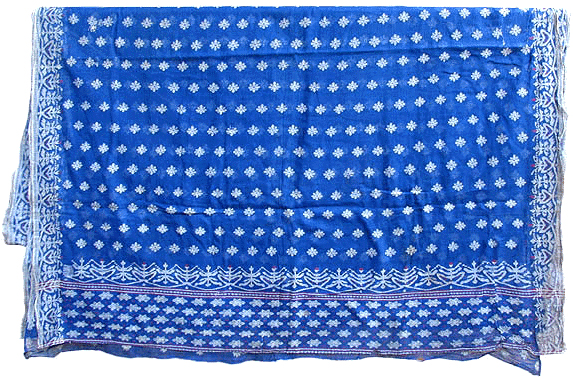The Ancient Artistry of Shantipur
BY: SUN STAFF - 2.8 2021

Shantipur is a famous center of Vaisnavism located in the Nadia district of West Bengal. It is best known to devotees as being the residence of the divine personality, Sri Advaita Acarya. After Lord Caitanya Mahaprabhu accepted the renounced order of life, Nityananda Prabhu accompanied Him on a trip to Jagannath Puri. On the way, Nityananda detoured the Lord first through Shantipur, to see Sri Advaita Acharya. It was also from Shantipur that the Lord rowed himself across the Ganges to Kalna.
The principle deity of Shantipur is Radharaman, who has been worshipped for long years by the family of Baro Gosai, descending from Mathuresh Goswami. The Deity was originally installed in Orissa by King Indradyumna, as a single image of Krishna named Dol Govinda. But when the king of Yessore (now in Bangladesh) attacked Orissa he brought the Deity back with him to his capital.
Later, during the reign of Mughal emperor Akbar, Yessore came under siege, during the reign of King Pratapaditya. The priest of the temple gave the Deity to his own guru, Mathuresh Goswami, to protect it during the time of unrest. The Goswami, realizing the gravity of the situation, took Dol Govinda to his ancestral home in Shantipur, where he reinstalled the Deity in a new temple. Srimati Radha was later installed alongside Dol Govinda, and together they were named Radharaman.
Sri Madan Gopal, the deity worshipped by Advaita Acharya, is also still worshipped here by heirs of Krishna Mishra, the second son of Advaita Acharya.
While much could be said about the glories of Sri Krsna and Srimati Radharani in their various Forms and Abodes here in Shantipur, today we are focusing on another thing the place is famous for: the beautiful Bengali sarees that have been handloomed here since ancient times. The art of weaving is one of the primary Vedic art. Know as suci-vaya-karma, the art of needleworks and weaving is one of the 64 transcendental arts of Srimati Radharani.

After the partition of India, many weavers came from Dhaka, Bangladesh and took up residence here in the Phulia region of Santipur. They were attracted to Shantipur not only for reasons of religion and politics, but because Shantipur was an ancient seat of weaving.
As described by Rupak Chatterjee, who narrates the video below, 'the famous Handloom Art of India, specially in Bengal (Nadia) District, a remote village, is disappearing every year. Across India, handloom weavers live in abject poverty earning approximately 70 rupees a day (around $2 a day) for their work. It takes at least one whole day to produce a saree, and that may not include additional threadwork or bhutti embellishments that are hand-sewn onto the cloth.
Shantipur, which was recently been declared a city, is just 90 kilometres (2 hours drive) north of the metropolis of Kolkata. Neighbouring Fulia is often mentioned in the same breath with Shantipur, because the two are perhaps the most renowned Bengal handloom saree weaving centres in all of Bengal. Shantipur and Fulia sarees are household names across India.

Nilambari Sari
Cotton, Dhaka, Undivided Bengal, early 20th c.
Gurusaday Museum, Joka, Kolkata
Shantipur has a history as a seat of Sanskrit literature and Vedic learning dating back to the 9th Century. The first recorded references to Shantipur as a handloom weaving centre are over 500 years old. Fulia, in contrast, became famous as a centre of handloom saree weaving more recently, thanks to the influx of immigrant weavers from Bangladesh (East Pakistan).
In the Shantipur/Fulia region there are more than 125,000 handlooms in operation. They are producing Shantipuri, Tangail, and Jamdani handloom sarees in a wide variety of yarns, from cotton to tussar and silk. Dhotis, chaddars, dupattas, etc. are also woven.
There are records of handloom saree weaving activity in Shantipur, a centre of Vaishnavite culture and Bhakti movement, from as early as the 15th Century. Weaving flourished throughout the medieval era, and the famed indigo-dyed Neelambari made the Shantipur saree a household name. Like Krsna Nilamadhava, nilambari literally means 'blue sky', referring to the saree's deep navy blue color.
There was a strong sense of identity among Shantipur weavers. They united to agitate against the stranglehold of the Dadni system of the British East India Company, and even took their grievances to the colonial courts near the end of the Raj.
In this century, the traditional methods of Shantipur weaving have gradually begun to change, being modernized with techniques like sectional warping and sizing that allowed production of warp yarns 350 yards long, and the use of machine made Jacquard borders.'






































